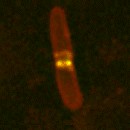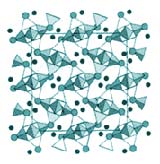Latest News

Waves make bug break point
Sloshing proteins help bacteria find their waists.
Chemical waves may help a bacterium to divide by pinpointing its middle, according to a new model of protein interactions 1 .
Bacteria such as Escherichia coli multiply by dividing. Bacterial division (called binary fission) is simpler than human cell division (mitosis). Human cells erect scaffolding to transport components to the two nascent daughter cells at either end; bacteria just pinch in two.

Tracking Stem Cells Implanted Into A Living Animal
Using tiny rust-containing spheres to tag cells, scientists from Johns Hopkins and elsewhere have successfully used magnetic resonance imaging to track stem cells implanted into a living animal, believed to be a first.
In the December issue of the journal Nature Biotechnology, the research team report that the neuronal stem cells take up and hold onto the spheres, which contain a compound of iron and oxygen. The iron-laden cells create a magnetic black hole easily spotted by magnetic resonan

Crystal’s Strange Behavior Could Enable Chemical Cleanup
Logic dictates that when you increase the pressure acting on a material, it should compact. So a report from an international team of scientists that they have discovered a crystal formation that expands under pressure is intriguing. The counterintuitive behavior may be exploited to make a crystal sponge for chemical cleanup.
Writing in the December 19 issue of the Journal of the American Chemical Society, the researchers describe the behavior of natrolite, a type of zeolite, under increasi

Taking up drinking in middle age cuts heart disease risk but increases chances of dying from other causes
Taking up regular drinking in middle age might cut the risk of heart disease, finds research in Heart. But the catch is, it increases the risk of dying from something else.
The researchers studied 7735 men from general practices in 24 British towns. The men were screened for heart disease between 1978 and 1980 when they were aged between 40 and 59. And they were asked about lifestyle, including smoking and drinking, and their medical history. Five years later, 7157 of them completed question

Hair samples may be more accurate measure of exposure to second hand smoke
Strands of hair accurately measure second hand tobacco smoke exposure, finds research in the Journal of Epidemiology and Community Health. And they may be more effective than currently used methods, suggest the authors.
Measuring levels of cotinine, a break-down product of nicotine, in the urine is often used to gauge second hand smoke exposure. But people vary considerably in how much of this substance they metabolise and eliminate, whatever their levels of exposure, and cotinine stays in t

New image analysis techniques to monitor how breast tumours respond to drugs
New techniques that might allow magnetic resonance imaging (MRI), to be used to give doctors subtle information about a tumour’s physiology and how it reacts to drug therapy are being developed.
The work is being carried out by doctors and medical physicists at the University of Aberdeen, with funding from the Swindon based Engineering and Physical Sciences Research Council.
Doctors treating cancerous tumours with drugs need to know quickly if the drug is having the desired effect t











